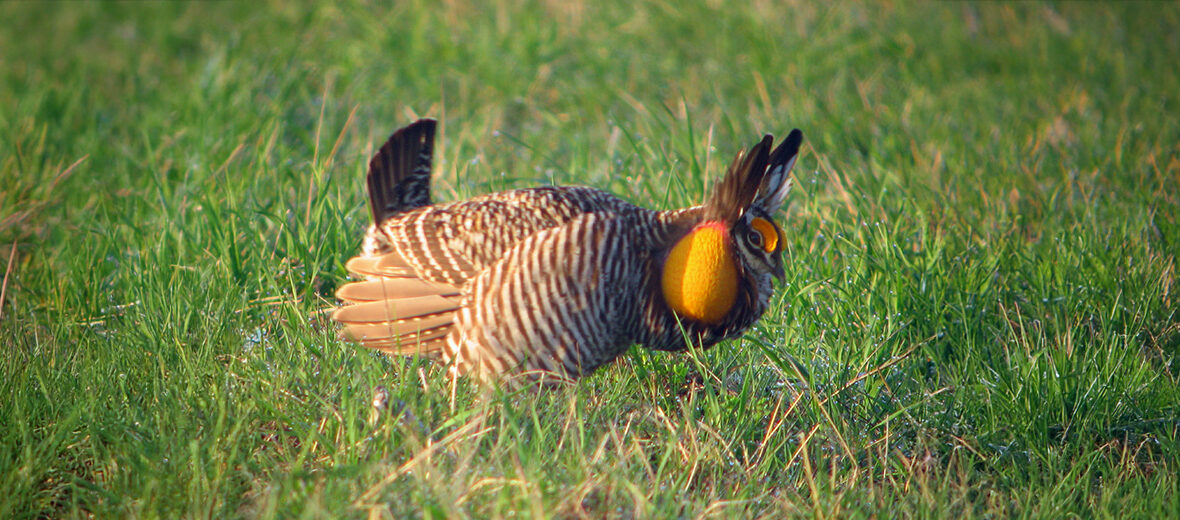
The greater prairie-chicken, aka pinnated grouse or boomer, can be found in south-central Canada and the central and eastern parts of the United States. These large grouse are becoming increasingly rare to see. They are threatened by habitat loss and destruction at the hands of farming, ranching, renewable energy, roads and railroads – that can result in habitat division and can cause vehicle strike (being hit by vehicles); hunting; trapping; invasive species, that can bring disease and predation; and pollution. Greater prairie-chickens are listed as Near Threatened as well as Largely Depleted by the IUCN. Their populations are increasing though due to conservation efforts.
First the Stats…
Scientific name: Tympanuchus cupido
Weight: Up to 42 ounces
Length: Up to 17 inches
Wingspan: Up to 28.5 inches
Lifespan: Up to 3 years
Now on to the Facts!
1.) There are only an estimated 360,000 wild individuals remaining.
2.) They are extirpated over much of their range due to habitat loss, natural disasters, and overhunting.
3.) Swedish naturalist and historian Carl Linnaeus first described these birds in the tenth edition of his Systema Naturae under the binomial name Tetrao cupido in 1758.
4.) The greater prairie-chicken is now placed together with the lesser prairie-chicken in the genus Tympanuchus that was introduced in 1841 by the German zoologist Constantin Gloger.
5.) They prefer undisturbed prairies and tallgrass prairies. These birds can tolerate agricultural land that is mixed with prairie land, but sparser population densities are found in areas that are more agricultural.
But wait, there’s more on the greater prairie-chicken!
6.) These birds were once widespread throughout the oak savanna and tall grass prairie ecosystems.
7.) The greater prairie-chicken feeds mostly on seeds and fruit, however during the summer they also eat green plants and insects like grasshoppers, crickets, and beetles.
Did you know…?
The greater prairie-chicken was nearly extinct in the 1930s due to hunting pressures and habitat loss. In Illinois, in the 1800s, the prairie-chicken numbered in the millions.
8.) In May 2000, the Canadian Species at Risk Act listed these prairie-chickens as extirpated in their Canadian range of Alberta, Saskatchewan, Manitoba, and Ontario. They were again confirmed by the Committee on the Status of Endangered Wildlife in Canada in November 2009.
9.) However, sightings and encounters do continue to occur in the south-central regions of Alberta and Saskatchewan, along with southern Ontario. Yet, sightings are extremely rare.
10.) Once numbering only an estimated 500 individuals, the Missouri Department of Conservation has begun a program to import prairie-chickens from Kansas and Nebraska in the hopes that they will be able to repopulate the state and increase that number to 3,000+.
But wait, there’s still more on the greater prairie-chicken!
11.) Central Wisconsin is currently home to approximately 600 individuals, which is down from 55,000 when hunting was prohibited in 1954.
12.) Presently, over 30,000 acres are managed by the Wisconsin Department of Natural Resources as greater prairie-chicken habitat.
Did you know…?
In Illinois, wildlife management included the “genetic rescue” of small and potentially inbred populations of these grouse by introducing birds from other areas.
13.) Birdwatchers travel from all over the world to visit Wisconsin in April for the Central Wisconsin Prairie Chicken Festival, which started in 2006 by Golden Sands Resource Conservation & Development Council, Inc.
14.) Studies have shown that mesopredators like striped skunks, raccoons, and opossums drastically increase egg mortality; experimental removal of these predators actually increased nesting success from 33% up to 82%.
15.) Subsequently, the loss of apex predators like bears, wolves, and mountain lions results in the increased populations of these mesopredators, and therefore reduces the populations of prairie-chickens, which is an example of a top-down trophic cascade.
But wait, there’s still a little more on the greater prairie-chicken!
16.) Greater prairie-chickens are not migratory.
17.) The mating displays of males consists of inflating their air sacs which are located on the sides of their neck and snapping their tails.
Did you know…?
A study of female prairie-chickens in Kansas discovered that their survival rates were 1.6 – 2 times greater during the non-breeding season compared to the breeding season; this was mainly due to the heavy predation which occurs during nesting and brood-rearing.
18.) Just 1 – 2 of the most dominant males are able to obtain 90% of mating opportunities.
19.) However, due to their now smaller populations and habitat fragmentation these prairie-chickens often experience inbreeding causing observable inbreeding depression: which causes fewer offspring and a decreased survival rate within these limited offspring further aiding in their population decrease.
20.) Females lay up to 17 eggs that hatch in up to 24 days.
But wait, there’s still a tad more on the greater prairie-chicken!
21.) Only 5 – 10 young survive per brood.
22.) Greater prairie-chickens are diurnal (active during the day).
23.) Bobcats, coyotes, foxes, hawks, owls, raccoons, and snakes all prey on greater prairie-chickens.
Now a Short Greater Prairie-Chicken Video!
Be sure to share & comment below! Also, check out the Critter Science YouTube channel. Videos added regularly!
Want to suggest a critter for me to write about? Let me know here.
Some source material acquired from: Wikipedia & IUCN
Photo credit: Greg The Busker




